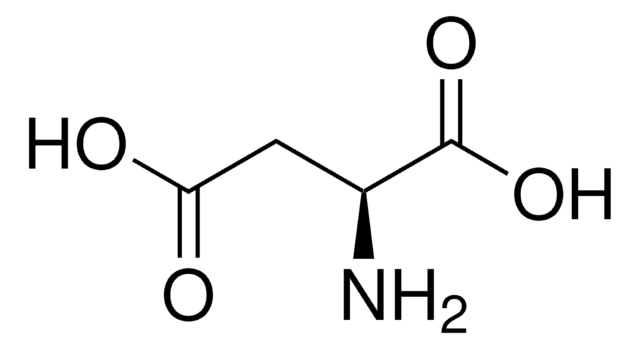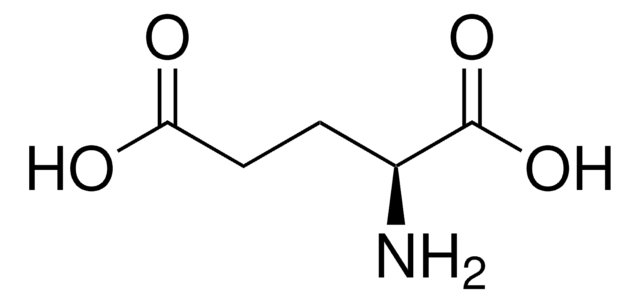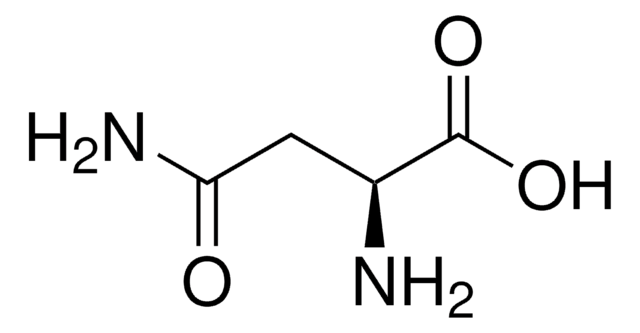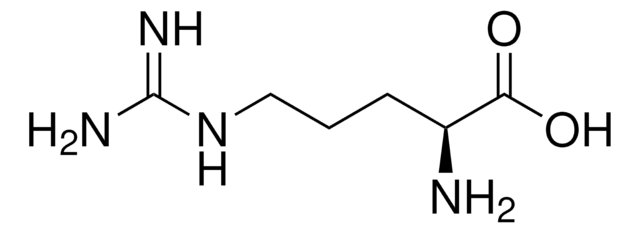A4534
L-Aspartic acid
BioReagent, suitable for cell culture, suitable for insect cell culture
Synonym(s):
(S)-(+)-Aminosuccinic acid, (S)-Aminobutanedioic acid
About This Item
Recommended Products
product line
BioReagent
Assay
≥98% (TLC)
form
powder
technique(s)
cell culture | insect: suitable
cell culture | mammalian: suitable
color
white to off-white
mp
>300 °C (dec.) (lit.)
SMILES string
N[C@@H](CC(O)=O)C(O)=O
InChI
1S/C4H7NO4/c5-2(4(8)9)1-3(6)7/h2H,1,5H2,(H,6,7)(H,8,9)/t2-/m0/s1
InChI key
CKLJMWTZIZZHCS-REOHCLBHSA-N
Gene Information
human ... CA1(759) , CA2(760)
rat ... Grin2a(24409)
Looking for similar products? Visit Product Comparison Guide
Biochem/physiol Actions
Storage Class Code
11 - Combustible Solids
WGK
WGK 1
Flash Point(F)
Not applicable
Flash Point(C)
Not applicable
Personal Protective Equipment
Regulatory Information
Choose from one of the most recent versions:
Already Own This Product?
Find documentation for the products that you have recently purchased in the Document Library.
Which document(s) contains shelf-life or expiration date information for a given product?
If available for a given product, the recommended re-test date or the expiration date can be found on the Certificate of Analysis.
How do I get lot-specific information or a Certificate of Analysis?
The lot specific COA document can be found by entering the lot number above under the "Documents" section.
How do I find price and availability?
There are several ways to find pricing and availability for our products. Once you log onto our website, you will find the price and availability displayed on the product detail page. You can contact any of our Customer Sales and Service offices to receive a quote. USA customers: 1-800-325-3010 or view local office numbers.
What is the Department of Transportation shipping information for this product?
Transportation information can be found in Section 14 of the product's (M)SDS.To access the shipping information for this material, use the link on the product detail page for the product.
What can I use to solubilize L-Aspartic acid, Product A4534?
This product is soluble in water at a concentration of 5mg/mL. Sigma has tested this product in 0.5M hydrochloric acid at a concentration of 50mg/mL, yielding a clear, colorless to faint yellow solution.
The description of L-Aspartic acid, Product A4534, says that it is "cell culture tested". What does that mean for this product?
Growth studies are carried through two subculture generations at 0.133 mg/mL. Cells are counted and growth is plotted as a logarithmic function of time in culture. Seeding efficiencies, doubling time, and final cell densities are determined. During the testing period, cultures are examined microscopically for atypical morphology and evidence of cytotoxicity.
What is the shelf life of L-Aspartic acid, Product A4534?
There is no expiration date or recommended retest date for this product. We will guarantee the product for one year from the date of shipment.
Do you have any solution stability information for Product A4534, L-Aspartic acid?
L-aspartic acid may be used in cell culture media from 0.00665 g/L up to 0.05 g/L. Most cell culture media has a minimum shelf life of 1 year at 2-8°C. A stock solution at 50 mg/mL should be stable at least 6 months at 2-8°C
My question is not addressed here, how can I contact Technical Service for assistance?
Ask a Scientist here.
Our team of scientists has experience in all areas of research including Life Science, Material Science, Chemical Synthesis, Chromatography, Analytical and many others.
Contact Technical Service





